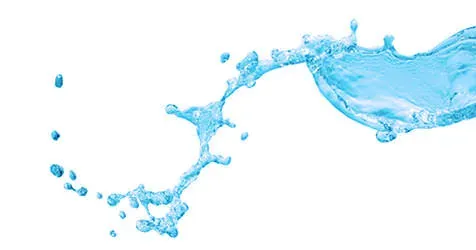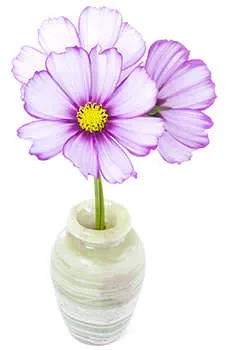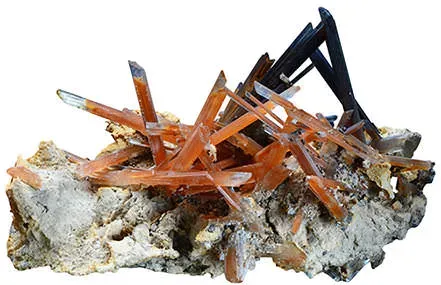 Gypsum is a hydrated calcium sulfate and is the most common sulfate mineral. It is also the most common evaporate, meaning a deposit that is left after water evaporates. The name gypsum is derived from Greek word gypsos, meaning 'plaster,' as it is used in plasters, such as plaster of Paris. Gypsum also has other industrial uses. It is used in fertilizers, cement, and as filler in paints and crayons. Gypsum is sometimes used in jewelry, but is extremely soft, so great care must be taken. In fact, gypsum is so soft that is can be easily cut with a knife, or scratched with a fingernail. There are several different types of gypsum used in jewelry: alabaster, satin spar, and selenite. These three varieties of gypsum are also used as decorative stones.
Gypsum is a hydrated calcium sulfate and is the most common sulfate mineral. It is also the most common evaporate, meaning a deposit that is left after water evaporates. The name gypsum is derived from Greek word gypsos, meaning 'plaster,' as it is used in plasters, such as plaster of Paris. Gypsum also has other industrial uses. It is used in fertilizers, cement, and as filler in paints and crayons. Gypsum is sometimes used in jewelry, but is extremely soft, so great care must be taken. In fact, gypsum is so soft that is can be easily cut with a knife, or scratched with a fingernail. There are several different types of gypsum used in jewelry: alabaster, satin spar, and selenite. These three varieties of gypsum are also used as decorative stones.
 The most commonly used variety of gypsum is alabaster. Alabaster was used in ancient Egypt and Rome for carving tombs, vases and other objects. Nowadays, the Japanese value the stone for its purity and cat's eye effect. In Russia, a golden or salmon colored variety of alabaster can be found, which is commonly carved into egg shaped pieces and called Pharaoh's eggs. Alabaster is usually found in pastel colors, however the stones are usually stained to become brighter colors. Satin spar is a fibrous variety of gypsum that has a silky luster and is often cut as cabochons. Sometimes satin spar is cut in the form of beads, or pear shaped drops, and used in jewelry. Satin spar is sold as luck stones at Niagara Falls, with the claim that the stones were found beneath the Falls at great peril.
The most commonly used variety of gypsum is alabaster. Alabaster was used in ancient Egypt and Rome for carving tombs, vases and other objects. Nowadays, the Japanese value the stone for its purity and cat's eye effect. In Russia, a golden or salmon colored variety of alabaster can be found, which is commonly carved into egg shaped pieces and called Pharaoh's eggs. Alabaster is usually found in pastel colors, however the stones are usually stained to become brighter colors. Satin spar is a fibrous variety of gypsum that has a silky luster and is often cut as cabochons. Sometimes satin spar is cut in the form of beads, or pear shaped drops, and used in jewelry. Satin spar is sold as luck stones at Niagara Falls, with the claim that the stones were found beneath the Falls at great peril.
 Selenite is another variety of gypsum. It is soft, transparent, and colorless, and only occasionally cut for collectors. The most highly prized varieties of selenite are the 'desert roses,' the swallow tail' twins, and stellate, or starlike forms. Gypsum only rates a 2 on the hardness scale. This softness causes the stone to break easily and weather badly. It is for this reason that the stone is usually used for statues and ornamental carvings, not jewelry. Gypsum is transparent to translucent with a vitreous luster. It is usually a white, pinkish, or brownish color. However the stone can also be various shades of yellow, gray, and red. Gypsum occurs in a variety of different places. It can be found in massive beds in sedimentary rocks with limestones and shale. It is also associated with calcite, sulfur,
Selenite is another variety of gypsum. It is soft, transparent, and colorless, and only occasionally cut for collectors. The most highly prized varieties of selenite are the 'desert roses,' the swallow tail' twins, and stellate, or starlike forms. Gypsum only rates a 2 on the hardness scale. This softness causes the stone to break easily and weather badly. It is for this reason that the stone is usually used for statues and ornamental carvings, not jewelry. Gypsum is transparent to translucent with a vitreous luster. It is usually a white, pinkish, or brownish color. However the stone can also be various shades of yellow, gray, and red. Gypsum occurs in a variety of different places. It can be found in massive beds in sedimentary rocks with limestones and shale. It is also associated with calcite, sulfur, ![]() quartz, dolomite, and halite. It can also be found as free crystals in clay, and as cap rock on salt domes. Some gypsum is deposited by the evaporation of salt water. It can also crystallize in dry lakes as soft, translucent crystals.
quartz, dolomite, and halite. It can also be found as free crystals in clay, and as cap rock on salt domes. Some gypsum is deposited by the evaporation of salt water. It can also crystallize in dry lakes as soft, translucent crystals.
 The different varieties of gypsum occur in Nova Scotia, Ontario, and New Brunswick in Canada, and in Languedoc-Rousillon and Alsace, France. In the United States, important mines are in Arizona, California, Utah, Colorado, Oklahoma, New Mexico, Ohio, Michigan, Virginia, Kentucky, Pennsylvania, Washington and New York. Most alabaster comes from Volterra in Tuscan, Italy, and from Derbyshire, Staffordshire and Nottingham, in England. Pink alabaster mines exist in the Vale of Glamorgan, in Wales. Spain, Australia, Germany, Kazakhstan, Mexico, Russia, the United Kingdom, Iran and Pakistan are also sites for alabaster. Gypsum has been said to possess qualities of protection and good fortune. It is a very useful stone for people who long to find themselves. It teaches us to listen to our inner voice, and it purifies our perception.
The different varieties of gypsum occur in Nova Scotia, Ontario, and New Brunswick in Canada, and in Languedoc-Rousillon and Alsace, France. In the United States, important mines are in Arizona, California, Utah, Colorado, Oklahoma, New Mexico, Ohio, Michigan, Virginia, Kentucky, Pennsylvania, Washington and New York. Most alabaster comes from Volterra in Tuscan, Italy, and from Derbyshire, Staffordshire and Nottingham, in England. Pink alabaster mines exist in the Vale of Glamorgan, in Wales. Spain, Australia, Germany, Kazakhstan, Mexico, Russia, the United Kingdom, Iran and Pakistan are also sites for alabaster. Gypsum has been said to possess qualities of protection and good fortune. It is a very useful stone for people who long to find themselves. It teaches us to listen to our inner voice, and it purifies our perception.